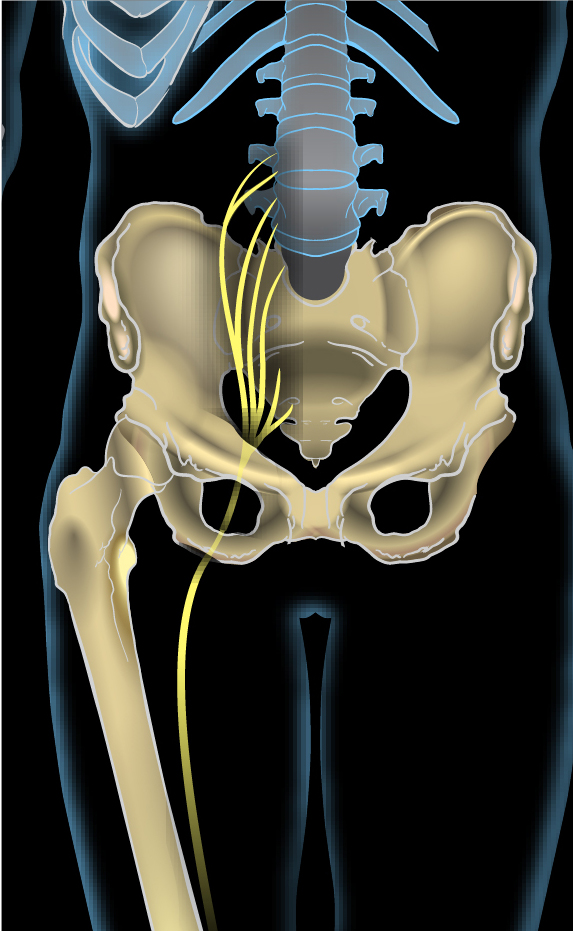Sciatica
(Redirected from Lumbar radiculopathy)
Editor-In-Chief: Prab R Tumpati, MD
Obesity, Sleep & Internal medicine
Founder, WikiMD Wellnesspedia &
W8MD medical weight loss NYC and sleep center NYC
| Sciatica | |
|---|---|

| |
| Synonyms | N/A |
| Pronounce | N/A |
| Specialty | N/A |
| Symptoms | Lower back pain, buttock pain, leg pain, numbness, tingling |
| Complications | Chronic pain, muscle weakness |
| Onset | Sudden or gradual |
| Duration | Days to weeks |
| Types | N/A |
| Causes | Herniated disc, spinal stenosis, piriformis syndrome, pregnancy |
| Risks | Obesity, sedentary lifestyle, age, diabetes |
| Diagnosis | Physical examination, medical imaging |
| Differential diagnosis | Peripheral neuropathy, hip arthritis, spinal tumor |
| Prevention | N/A |
| Treatment | Pain management, physical therapy, surgery |
| Medication | NSAIDs, muscle relaxants, steroids |
| Prognosis | N/A |
| Frequency | Common |
| Deaths | N/A |
Sciatica is a symptom of a problem with the sciatic nerve, the largest nerve in the body. Sciatic nerve controls muscles in the back of your knee and lower leg and provides feeling to the back of your thigh, part of your lower leg, and the sole of your foot.
What is sciatica pain?
- Sciatica is pain along the sciatic nerve, which runs down the length of the leg to the foot
- Usually caused by pressure on the nerve due to disk prolapse or a tumor, abscess, or blood clot.
Symptoms
- When you have sciatica, you have pain, weakness, numbness, or tingling.
- It can start in the lower back and extend down your leg to your calf, foot, or even your toes.
- It's usually on only one side of your body.
Causes
- A ruptured intervertebral disk
- Narrowing of the spinal canal that puts pressure on the nerve, called spinal stenosis
- An injury such as a pelvic fracture.
- In many cases no cause can be found.
- Sometimes sciatica goes away on its own.
| Nerves of the lumbosacral plexus | ||||||||||||||
|---|---|---|---|---|---|---|---|---|---|---|---|---|---|---|
|
Transform your life with W8MD's budget GLP-1 injections from $125.
W8MD offers a medical weight loss program to lose weight in Philadelphia. Our physician-supervised medical weight loss provides:
- Most insurances accepted or discounted self-pay rates. We will obtain insurance prior authorizations if needed.
- Generic GLP1 weight loss injections from $125 for the starting dose.
- Also offer prescription weight loss medications including Phentermine, Qsymia, Diethylpropion, Contrave etc.
NYC weight loss doctor appointments
Start your NYC weight loss journey today at our NYC medical weight loss and Philadelphia medical weight loss clinics.
- Call 718-946-5500 to lose weight in NYC or for medical weight loss in Philadelphia 215-676-2334.
- Tags:NYC medical weight loss, Philadelphia lose weight Zepbound NYC, Budget GLP1 weight loss injections, Wegovy Philadelphia, Wegovy NYC, Philadelphia medical weight loss, Brookly weight loss and Wegovy NYC
|
WikiMD's Wellness Encyclopedia |
| Let Food Be Thy Medicine Medicine Thy Food - Hippocrates |
Medical Disclaimer: WikiMD is not a substitute for professional medical advice. The information on WikiMD is provided as an information resource only, may be incorrect, outdated or misleading, and is not to be used or relied on for any diagnostic or treatment purposes. Please consult your health care provider before making any healthcare decisions or for guidance about a specific medical condition. WikiMD expressly disclaims responsibility, and shall have no liability, for any damages, loss, injury, or liability whatsoever suffered as a result of your reliance on the information contained in this site. By visiting this site you agree to the foregoing terms and conditions, which may from time to time be changed or supplemented by WikiMD. If you do not agree to the foregoing terms and conditions, you should not enter or use this site. See full disclaimer.
Credits:Most images are courtesy of Wikimedia commons, and templates, categories Wikipedia, licensed under CC BY SA or similar.
Translate this page: - East Asian
中文,
日本,
한국어,
South Asian
हिन्दी,
தமிழ்,
తెలుగు,
Urdu,
ಕನ್ನಡ,
Southeast Asian
Indonesian,
Vietnamese,
Thai,
မြန်မာဘာသာ,
বাংলা
European
español,
Deutsch,
français,
Greek,
português do Brasil,
polski,
română,
русский,
Nederlands,
norsk,
svenska,
suomi,
Italian
Middle Eastern & African
عربى,
Turkish,
Persian,
Hebrew,
Afrikaans,
isiZulu,
Kiswahili,
Other
Bulgarian,
Hungarian,
Czech,
Swedish,
മലയാളം,
मराठी,
ਪੰਜਾਬੀ,
ગુજરાતી,
Portuguese,
Ukrainian
Contributors: Prab R. Tumpati, MD



